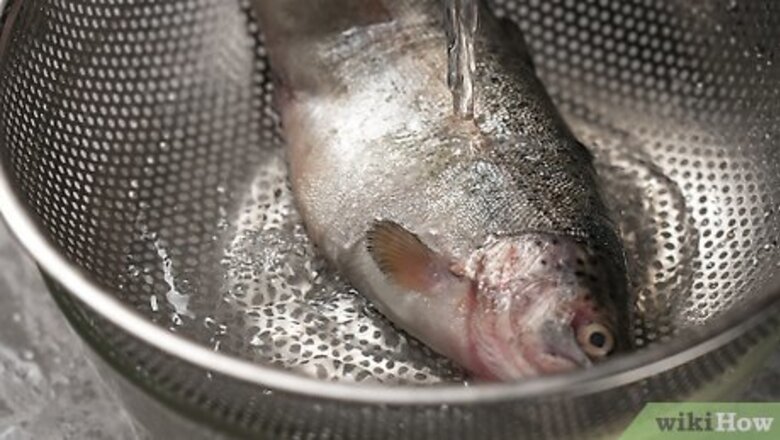
views
Cutting Trout for Cleaning
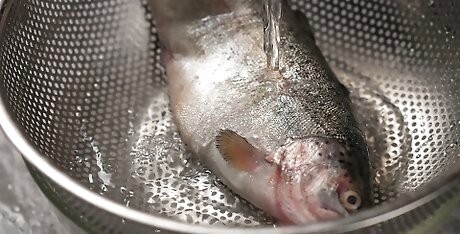
Rinse the fish and position it on its side. Hold your fish under cold running water to remove slime from it. Lay out a cutting board on a flat surface, like a counter or table. Position the fish flat on its side, with the bottom of the fish facing towards you. Cleaning a fish is messy work. Lay down a plastic table cover or butcher paper on your work surface for easy cleanup.
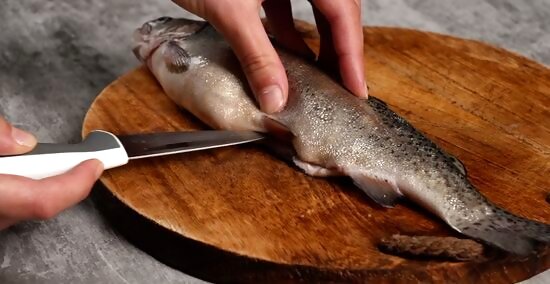
Slit the fish from anus to throat. The anus of the trout will appear like a small round hole on the bottom of the fish, a little over halfway from the head to the tail. Insert the tip of the knife into the anus and cut shallowly along the belly towards the head. When your knife is about even with the gills, remove it from the fish. Cutting too deeply could cause the knife to penetrate the intestines. Puncturing the intestines will release whatever was digesting in the fish and is often accompanied by an unpleasant odor. Accidentally cutting into the intestines will expose the meat to enzymes and bacteria. This may cause the fish to spoil faster. Rinse digested matter thoroughly from the fish if this happens.
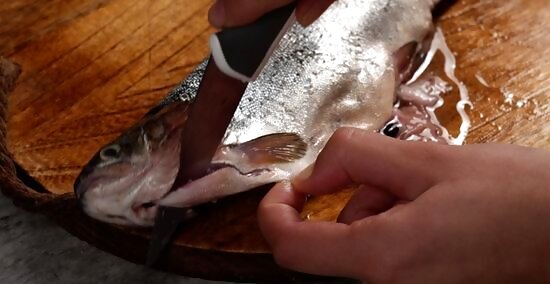
Separate the gills from the head with your knife. Cut through the skin connecting the mouthward curving base of the gills and the head of the fish. The knife should sever the skin a short distance before the bottom of the mouth, on what might be considered the “chin” of the fish.
Removing the Entrails, Head, and Fins
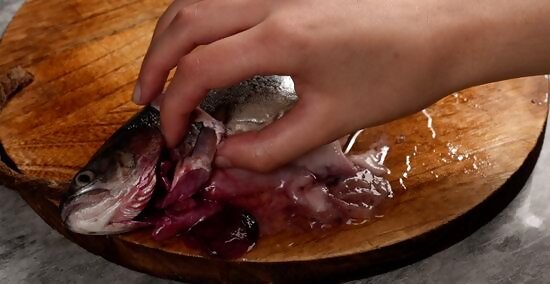
Open the body and remove entrails from the fish. Pry open the body with your hands. Hold the fish by its jaw with one hand and grasp the gills with the other. Pull firmly on the gills to remove them along with accompanying guts. Loose entrails should be put into a separate plastic bag before being thrown away. This will cut down on flies and the appearance of other pests.
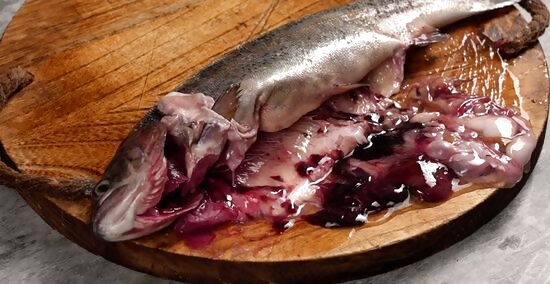
Scrape out the kidney of the fish. Look along the length of the bottom of the backbone to find the kidney. It should be dark colored and span much of the backbone. Cut along the length of the kidney with your knife and then scrape it away with your finger or a tool, like a spoon. When the kidney is cut, it’ll release a dark red colored fluid. This should be rinsed away after the kidney is removed.
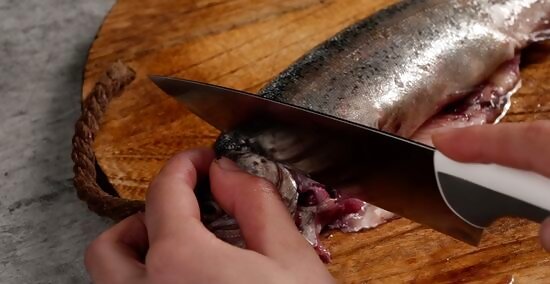
Remove the head and fins. Fish can be stored with the head still attached, but it may be most space efficient for you to cut it off. Insert your knife into the initial cut made for the gills and firmly press down on it until the head is removed. Similarly, the dorsal fin can be left on the fish, but to remove it, grip the fin firmly and cut shallowly along the top of the fish to remove it. After removing the head and fins, only the spine, meat, and skin should remain. Your fish is ready to be filleted and skinned or stored for later. Although removing the head of the fish can make it easier to store, which can be especially useful when freezing a big catch, leaving the head of the fish attached will help prevent it from spoiling.

Store your cleaned trout in your refrigerator. Now that the cutting and gutting is done, rinse your fish thoroughly in cold water. Packed in ice, your trout should stay good up to two weeks. If kept frozen below freezing, your trout can last for roughly two months. If you plan on freezing fish, consider vacuum sealing it first. This will protect the fish from freezer burn and can increase its shelf life up to three or four months. Double wrap fish stored in the refrigerator with plastic bags. Squeeze excess air from the bags before refrigerating. This can prevent a fishy odor from developing in your refrigerator.
Filleting and Skinning Trout
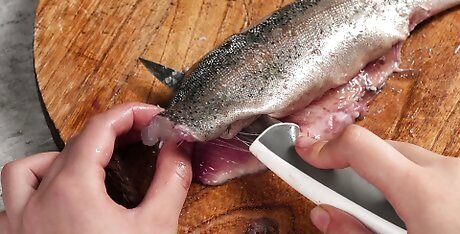
Cut the fish at the gill line. Insert your knife into the gap directly behind the gills (or where the gills were). Cut toward the backbone of the fish until you reach it. Use moderate force when cutting to prevent cutting through the backbone, which will serve as a guide for your knife. Once you have reached the backbone, keep your knife inserted in the fish in preparation for the following cut. Fish can be filleted and skinned without being cleaned first. However, to prevent accidentally piercing the entrails, clean the fish first. If you decide to clean your fish before filleting and skinning it, leave the head on the fish so you have somewhere to hold onto later.
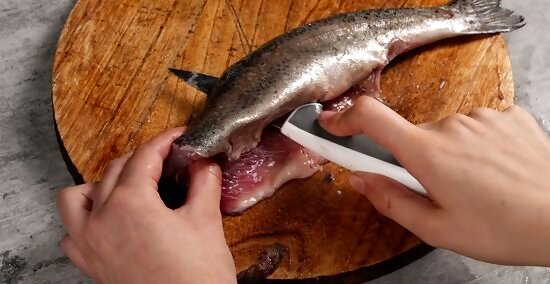
Follow the backbone with your knife while cutting toward the tail. Turn the blade of your knife toward the tail of the fish. Run the knife along the backbone and through the ribs until you reach the tail. Stop your cut at the tail, which you should leave on to make skinning the fish later easier. This same cut, into the gills, along the backbone, and down to the tail should be repeated on the opposite side of the fish. Hold the fish by the head while doing this. In some cases, you may be able to hook a finger around the jaw of the fish for a superior grip.
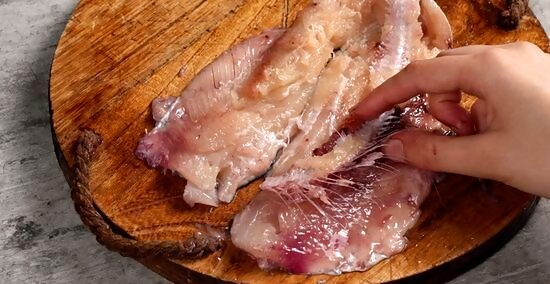
Remove the rib cage from the meat. Open the gutted fish so the meat is accessible. The meat will still have bones from the rib cage in it. Use your knife to cut out large masses of bones and your fingers to pick out what remains. Use gentle, firm movements when removing the rib cage. You may be able to pull most of the bones out as part of a single connected piece.
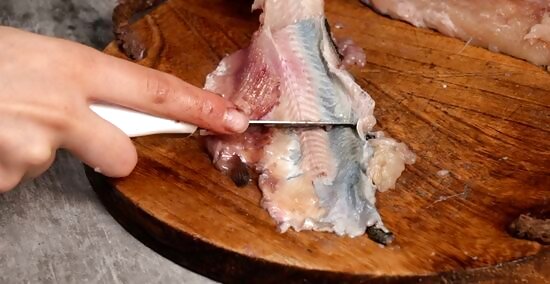
Skin the trout. Lay your fillets on a flat surface with the skin facing downward. Insert your knife into the meat about a half inch (1.27 cm) away from the tail. Hold the knife at an angle to the skin while gripping the tail firmly, then cut the meat free of the skin. The knife should run along the skin but not cut through it. In some regions or when crossing state/country lines, you may be required to leave a patch of skin on the fish so it can be identified and checked against your fishing permit.











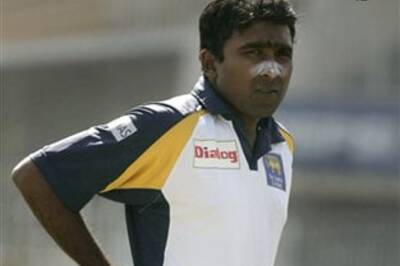
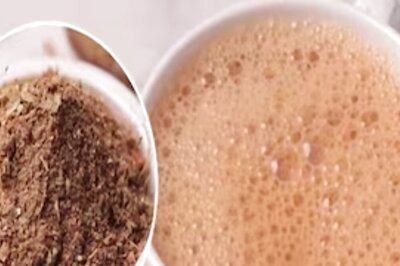




Comments
0 comment